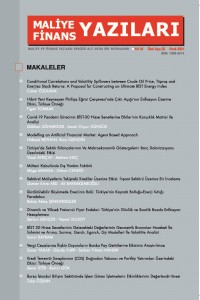Öz
21. yüzyılda yaşanan göç olgusunun geleneksel bakış açılarından farklılaşan bazı yönleri söz konusudur. Özellikle 2010 yılında Ortadoğu’da yaşanan toplumsal hareketler sonucunda küresel göçün mülteci sorununa dönüştüğü görülmektedir. Bu çalışma, az gelişmiş ve gelişmekte olan ülkelerdeki göçü engellemeye yönelik dış yardım politikasının, son yıllarda en çok mülteci kabul eden ülkelerden biri olan Türkiye’nin mülteci kabulüne olan etkisini incelenmeyi amaçlamaktadır. Bu amaçla 1990-2018 dönemi verileri kullanılarak yapılan analiz sonuçları, Türkiye’ye yönelik dış yardım arttıkça mülteci sayısının da arttığını göstermektedir. Ayrıca elde edilen diğer bulgulara göre ekonomik büyüme ve demokrasinin güçlenmesi mülteci sayısını artırırken, nüfus artışı ise azaltmaktadır.
Anahtar Kelimeler
Kaynakça
- Azam, J. P. & Berlinschi, R. (2009). The Aid Migration Trade-Off. Toulouse School of Economics Working Paper Series 09-077, 1-33.
- Bermeo, S. B. & Leblang, D. (2015). Migration and Foreign Aid. International Organization, 69, 627-657. doi:10.1017/S0020818315000119.
- Berthelemy, J. C., Beuran, M. & Maurel, M. (2009). Aid and Migration: Substitutes or Complements?. World Development, 37(10), 1589-1599.
- Clist, P. & Restelli, G. (2020). Development Aid & International Migration to Italy: Does Aid Reduce Irregular Flows?. World Economy. doi: 10.1111/TWEC.13017.
- Dreher, A., Fuchs, A. & Langlotz, S. (2019). The Effects of Foreign Aid on Refugee Flows. European Economic Review, 112, 127-147.
- Gamso, J. & Yuldashev, F. (2017). Targeted Foreign Aid and International Migration: Is Development Promotion an Effective Immigration Policy?. Aid Data Working Papers, 1-32.
- Gamso, J. & Yuldashev, F. (2018). Does Rural Development Aid Reduce International Migration?. World Development, 110, 268-282.
- Gygli, S., Haelg, F., Potrafke, N. & Sturm, J. E. (2019). The KOF Globalisation Index-Revisited. Review of International Organizations, 14(3), 543-574. https://doi.org/10.1007/s11558-019-09344-2.
- https://www.bbc.com/turkce/haberler-dunya-51724776, Erişim Tarihi: 11.08.2020.
- https://www.theglobaleconomy.com/, Erişim Tarihi: 28.06.2020.
- Idriz, N. (2018). The EU-Turkey Statement or the ‘Refugee Deal’: The Extra-legal Deal of Extraordinary Times?. In Dina Siegel & Veronika Nagy (Eds.), The Migration Crisis?: Criminalization, Security and Survival (pp. 61-84). Den Haag: Eleven International Publishing.
- Lanati, M. & Thiele, R. (2017). The Impact of Foreign Aid on Migration Revisited. European University Institute Working Papers, 1-30.
- Menard, A. & Gary, A. (2018). Aid, Trade and Migration: How Do Bilateral Flows Interact?. World Economy, 41, 431-456.
- Murat, M. (2020). Foreign Aid, Bilateral Asylum Immigration and Development. Journal of Population Economics, 33, 79-114. https://doi.org/10.1007/s00148-019-00751-8. Pesaran, M. H., Shin, Y. & Smith, R. J. (2001). Bounds Testing Approaches to the Analysis of Level Relationships. Journal of Applied Econometrics, 16(3), 289-326.
- Schilling, T., Rauscher, S., Menzel, C., Reichenauer, S., Muller-Schilling, M., Schmid, S. & Selgrad, M. (2017). Migrants and Refugees in Europe: Challenges, Experiences and Contributions. Visceral Medicine, 33, 295-300. DOI: 10.1159/000478763.
- Ugarte, D. & V. Verardi, V. (2010). Does Aid Induce Brain Drain? The Effect of Foreign Aid on Migration Selection. CRED Working Papers, 1-38.
- UNHCR (2019). Global Trends: Forced Displacement in 2019.
- World Bank (2020). World Development Indicators, https://data.worldbank.org/indicator, Erişim Tarihi: 28.06.2020.
- Yıldız, F. (2019). Akdeniz’de Düzensiz Göç ile İnsan Ticaretinin Türkiye’nin Güvenliğine Etkileri. (Hasret Çomak & Burak Şakir Şeker, Editörler). Akdeniz Jeopolitiği içinde (ss. 699-716). Ankara: Nobel Akademik Yayıncılık.
- Zivot, E. & Andrews, D. (1992). Further Evidence of the Great Crash, the Oil-Price Shock and the Unit-Root Hypothesis. Journal of Business and Economic Statistics, 10, 251-270.
Ayrıntılar
| Birincil Dil | Türkçe |
|---|---|
| Konular | Finans |
| Bölüm | Makaleler |
| Yazarlar | |
| Yayımlanma Tarihi | 2 Şubat 2021 |
| Gönderilme Tarihi | 19 Aralık 2020 |
| Yayımlandığı Sayı | Yıl 2021 Sayı: Özel Sayı 2 |
Kaynak Göster
Maliye ve Finans Yazıları dergisinin kapsamını ekonomi, maliye, finans ve bankacılık alanlarındaki çalışmalar oluşturmaktadır.


